| Published
on 26
Oct
2012 |
All rights reserved.
|
|
|
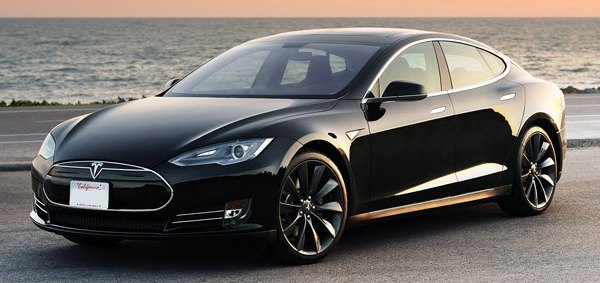 |
|
Tesla's
new EV wants to compete with conventional cars directly – and beat them.
|
|
You can't help
admiring what Tesla has achieved so far. This silicon valley-based
electric car maker has never really turned a profit since its formation
in 2003, yet it keeps attracting investment, gaining size and fame and
even getting floated on the stock market. Such achievements are not
credited to the first car it built, the Roadster,
but to the expectation for its second car, Model S. The Model S is a
much more ambitious project. While the Roadster was more an experiment
to demonstrate the feasibility of EVs in real-world usage, the Model S
wants to compete with conventional cars directly – and beat them. Tesla
plans to build 20,000 units of this car annually at the ex-NUMMI plant
it acquired cheaply from Toyota. Its prices range from US$60,000 to the
north of $100,000, so it will compete with the high-end BMW 5-Series /
Audi A6 / Mercedes E-class / Jaguar XF as well as performance sedans
like M5, S6 / RS6, E63, Panamera and Quattroporte. Is it that good? We
shall see…
From outside, you can hardly guess it is an electric car. Sure, the
slippery shape is quite sporty and stylish, but you can say the same
things to an Audi A7 or Mazda 6. There is a pseudo front grille whose
existence is just to satisfy conservative buyers who are not accustomed
to EVs. Ridiculous! Without an engine occupying the front, the latter
could have been made much shorter and lower than that of conventional
cars, but once again Tesla opted for a conventional shape. These are
evidences that the company wants to play safe with its most important
product because it cannot afford any failures. However, it also means a
lot of opportunities have been lost. Perhaps the next product from
Tesla could be shaped more adventurous.
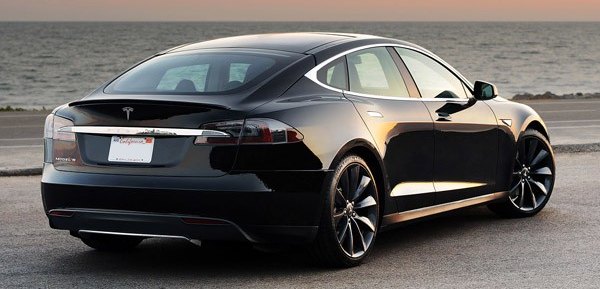 |
|
It
is a beautiful car, but the styling could be more adventurous given the
packaging advantages of EV.
|
|
On the plus side, I am glad that the Tesla sedan does not look like
Fisker Karma. A Coke-bottle shape body may be attractive to eyes but it
does not benefit cabin space. In contrast, the body shell of Model S
encloses a spacious interior for 5 large guys and a pair of luggage
compartments (one at the front and another at the tail) with a combined
capacity of 895 liters!
A large tailgate eases your access to the huge trunk. Moreover, if you
have too many children, you can fit the smallest 2 to a pair of
rear-facing child seats flipped from the trunk floor. In this way the
car offers an unrivalled 5+2 seating! What else can you ask for?
Considering it packs so much space inside, the exterior styling is all
the more admirable. It uses curves and sharp edges cleverly to deliver
a visual appearance lighter and slimmer than it is. The turbine wheels
are stylish, too. Who is responsible for this design? Franz von
Holzhausen, the guy famed for Mazda Kabura concept car that won our
AutoZine Concept Car award in 2006, also the designer of Pontiac
Solstice. Perhaps not happy with the corporate bureaucracy that put his
fine works on shelf or kill them off early, he joined Tesla as its
design chief in 2008.
Benefited by the sealed front grille, the car achieves a class-leading
drag coefficient of 0.24. That also matches the production car record
currently held by Mercedes E-class Coupe.
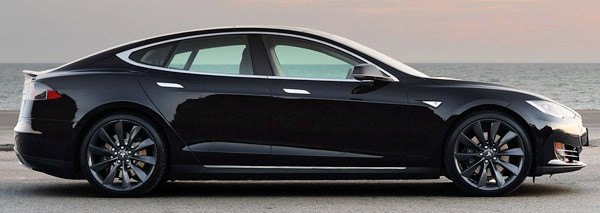 |
|
2
trunks, 7+2 seating and a drag coefficient of 0.24, all sound
incredible by conventional wisdom.
|
|
This car is about as large as Fisker Karma. It measures 5 meters long,
2 meters wide and runs a wheelbase close to 3 meters, slightly larger
than a Porsche Panamera. Although the monocoque body is primarily made
of aluminum with boron steel reinforcement, its sheer size and the
weight of batteries result in a kerb weight of 2100 kg. Nevertheless,
like
other electric cars, it is able to place the weight at optimum
position, i.e. the floorpan. A 100mm-thick floorpan contains
lithium-ion batteries of up to 85kWh capacity. This ensures a center of
gravity as low as sports cars. Moreover, the rigidly constructed
floorpan is a stress member contributing to chassis rigidity. It saves
the need for a strong backbone, thus enables a flat cabin floor to
benefit the middle rear passenger. The 3-phase AC induction motor and
single-speed step-down transmission are located right between the rear
wheels and drive the latter. Regular models get 362 horsepower and 325
pound-foot of torque, while Performance model uses a more powerful
motor to deliver 416 hp and 443 lbft, good enough to register 0-60 mph
in a remarkable 4.4 seconds. Top speed, however, is limited to 130 mph
to conserve battery.
Both the double-wishbone front and multi-link rear suspensions are
fashioned in aluminum and served with height adjustable adaptive air
springs like many luxury limousines. The steering is electrically
assisted, of course.
Depending on your investment you can choose different battery
capacities: $60,000 gets you a 40kWh pack good for 140 miles range
according to EPA test cycles. $70,000 gets 60kWh and 200 miles, while
$80,000 gets 85kWh and 265 miles. With the latter, the Model S is the
first production EV that we don't need to worry running out of battery
during the trip, even though the EPA figures could be a little
optimistic.
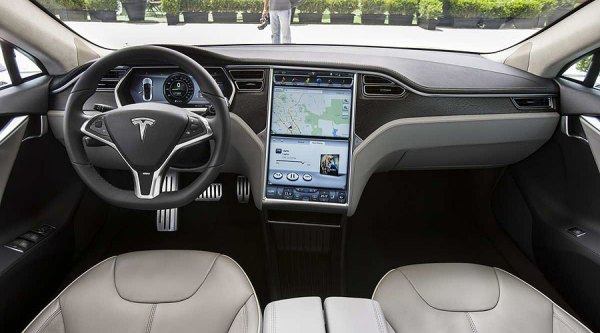 |
|
Build
quality is not perfect, but the 17-inch touchscreen is simply
jaw-dropping.
|
|
As expected for a start-up manufacturer, the build quality is not
perfect. You can pick a few misaligned panels or bad sealing here and
there, but overall the build quality is much better than Fisker. As the
ex-NUMMI plant is ramping up production, build quality is expected to
improve further. However, the interior does show signs of cheapness in
the materials used. You can spot the column stalks and some switches
from Mercedes' parts pool (note: Daimler holds a minority stake in
Tesla), whose quality are not bad but they look at odds to the space
age design. The steering wheel, the seats and leather trim also look
cheaper than the cars of this class deserve.
To reduce the use of purchased or costly bespoke switch gears, Tesla
puts nearly all the cabin and driving functions to a couple of LCD
screens. One is the digital instrument panel, another is a huge,
17-inch touchscreen occupying the whole center console. This is the
largest display ever been used on production cars. It runs Android
operating system (as Google's founders invested in Tesla since 2006)
and provides all the functions you can dream of, from air-con, audio,
satellite navigation, seat adjustment, suspension setting to web
surfing. The large screen provides unparalleled clarity, though its
fitment into the console is not so elegant.
 |
|
The
powertrain and chassis dynamics are so well engineered that it does not
sound like the work of a new company.
|
|
How does it drive on road? Surprisingly good. Although its
power-to-weight ratio is not very high, the Performance model does
provide ample torque right from nearly zero rpm. Coupling to the lack
of gearchange, the stream of acceleration is uninterrupted. No wonder
Motor Trend magazine managed to time 0-60 mph in only 3.9 seconds. This
places it very close to the super sedans like M5 and E63. It struggles
to match those rivals beyond 100 mph, and would surrender at 130 mph,
but you have to remember this car is not supposed to be a sport sedan
from the outset. Its near silent powertrain promotes a completely
different driving character that president Barek Obama might call it
"smart performance". The only thing to remind you about the speed is
the wind noise and tire roar, which could be annoying in the absence of
beautiful exhaust note.
Despite of the immense weight, the low center of gravity gives the
Model S an agile feel. It rolls more than a proper sports sedan in
corner, but it feels light and eager to steer – the latter must be
attributed to its 48:52 weight distribution and low polar moment of
inertia (all the powertrain and batteries are located within the
wheelbase). The Michelin Pilot Sport tires offer good grip. The ride
quality is excellent. The braking is strong. Only the steering cries
for more feedback. Overall, the powertrain and chassis dynamics are so
well engineered that it does not sound like the work of a new company.
This is a far better effort than the Fisker Karma. It deserves a sales
success, although its high cost could raise some questions. I sincerely
hope Tesla could overcome the hurdles of build quality, credibility and
cost control, i.e. factors that dragged down many new automotive
ventures. If it cannot succeed, it would be a blow to innovation in the
automotive industry.
|
Verdict:     |
Published
on 28
Jan 2015
|
All rights reserved.
|
|
Model S P85D - 4WD and even faster!
|
|
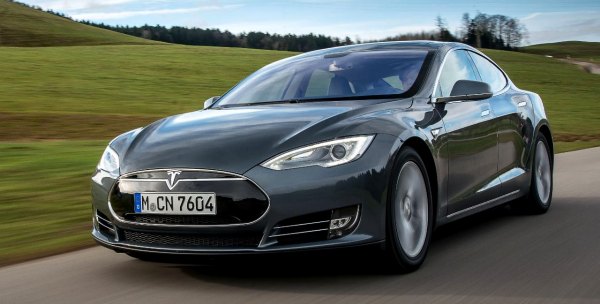 |
|
Tesla
said it sprints from rest to 60 mph in 3.2 seconds, matching the mighty
McLaren F1...
|
|
Rising from a Silicon
Valley startup to a model for Detroit and the world to learn from,
Tesla is
the greatest miracle we have seen for years. It also brings many
surprises to the increasingly predictable automotive world. The latest
surprise is the dual-motor, 4-wheel-drive version of Model S called
P85D – where D stands for Dual-motor, P for Performance and 85 denotes
its battery capacity in kWh. Tesla said it sprints from rest to 60 mph
in an incredible 3.2 seconds, matching the mighty McLaren F1 and
beating all performance sedans currently available – Mercedes E63 AMG S
4matic, Audi RS6/RS7 and Porsche Panamera Turbo S included. And this is
no wild claim because Motor Trend has already timed the car to do so in
3.1 seconds. How
can it do that?
The dual-motor 4WD layout was originally developed for Model X, Tesla’s
new SUV. Since the launch of that car has been delayed, Tesla
introduces it to the Model S first. An additional electric motor is
added to the front axle to drive the front wheels. It produces up to
221 horsepower and 244 pound-foot of torque. The rear-axle motor is
unchanged, but it has been re-rated to 470 hp recently (note that it
now represents the capability of the motor instead of whole system
whose bottleneck is at the battery and inverter). The combined maximum
output is
therefore an astonishing 691 hp and 687 lbft. Looking around the 4-door
world, only the 707 hp Dodge Charger Hellcat is more powerful, but the
P85D has more torque and that peak torque is instantly available once
you floor down the throttle. Coupling to the 4-wheel-drive traction, no
wonder it could be so quick to 60 mph.
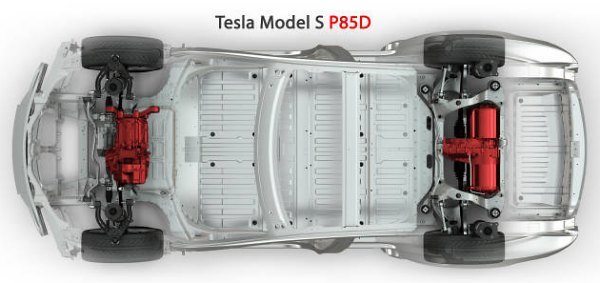 |
|
Despite
the supercar performance, the P85D is not exactly a performance sedan
in the same breath as AMG, M or RS...
|
|
On the road, the P85D feels really sensational. Accelerating up to 70
or 80 mph, the sense of g-force is just as breathtaking as a Bugatti
Veyron SS, thanks to the constant pour of tremendous torque. There is
no gearshift to interrupt the acceleration. With excellent traction it
wastes no time in wheel spin either, so it translates the force into
motion instantly, pressing your head hard onto the headrest until
three-figure speed or you back off. Admittedly, at higher speeds the
power fades out more quickly than conventional engines. Up to 100 mph
it might still edge out the aforementioned German performance sedans.
From there to its 155 mph top speed – which is lifted from 130 mph of
the rear-drive car – it loses ground. On Autobahn that will be a
problem, but elsewhere people will prefer its superior acceleration at
lower, more accessible speed range.
However, despite of the supercar performance, the P85D is not exactly a
performance sedan in the same breath as AMG, M or RS. Save the
dual-motor powertrain it is no different to the regular Model S, with
the same suspension, tires and brakes. Take it to a road course and you
will find it corners and stops less swiftly. The car is very heavy at
2.2 tons, but it is well balanced and agile. Its front-to-rear weight
distribution is worsened from 47:53 to a still pretty good 51:49, and
the center of gravity remains lower than conventional cars. It just
lacks the sporty suspension tuning, performance tires and brakes to be
a true sports sedan. If Tesla develops in that direction, the German
has to be worried.
|
Verdict:     |
Published
on 9
Oct 2015
|
All rights reserved.
|
|
Model S P90D Ludicrous
|
|
 |
|
Performance
upgrade could not come easier than this: a new fuse!
|
|
In the new world
order of electric cars, performance can be extracted in a ridiculously
effortless way. Take Tesla P85D for example, when you engage its
“Insane” mode, it is good for 0-60 mph in 3.1 seconds or faster than a
McLaren F1, but nothing could be more effortless in the way it
accelerates – no exhaust note, no tire squeal, no smoke and no
transmission clunks. One step of the pedal is followed immediately by a
quiet whine and linear stream of g-force. 3 ticks later, you have
passed the acceleration benchmark. So easy!
The new P90D with “Ludicrous” mode option is practically the same, just
gifted with even more spectacular performance. This time it is capable
to do 0-60 in 2.8 seconds, or the level of LaFerrari. However, what
impresses me is how effortless Tesla has the car developed. Based on
P85D, it needs only an upgraded battery (90kWh instead of 85kWh), a new
fuse and revised software to boost its maximum output from 691 to 762
hp and extend its driving range by 6 percent. Can’t you believe? If it
was a conventional car, it would have needed a bigger engine and beefed
up transmission at least, while a larger fuel tank would have required
some modifications to the chassis.
Moreover, existing owners of P85D can have their cars upgraded to the
aforementioned spec. if they pay US$3,000 for the battery swap and
another US$10,000 for the Ludicrous mode software and new fuse. Well,
actually it is not a fuse but an electronic overcurrent protective
device with heavy-duty contactors. It is capable to withstand 1500A of
battery current, compared to 1200A of the outgoing fuse. This explains
why the unchanged electric motors can generate higher output. The
battery and fuse swap can be done in Tesla’s service centers.
Performance upgrade has never been so easy! And most important, profit
has never been so easy to earn! Don't forget Silicon Valley guys
invented the New Economy.
|
Verdict:     |
Published
on 25
Jan 2017
|
All rights reserved.
|
|
Model S P100D
|
|
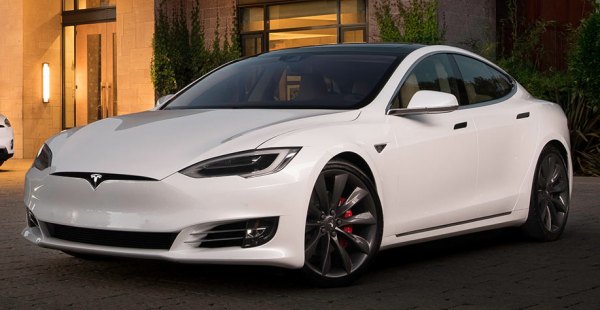
|
|
New
battery gives more range and even faster acceleration.
|
|
Since its birth 4 years
ago, Tesla Model S has been surprising the world. Not only it proves
that EVs could be workable on daily basis yet desirable to own, in the
past couple of years it also surprised us by adding supercar
performance to the equation. The first dual-motor P85D matched McLaren
F1 with a 0-60 mph time of 3.2 seconds, then it was superseded by P90D,
which raised the bar to a LaFerrari-matching 2.8 seconds. Just when we
thought that is already too quick for an executive sedan, Elon Musk
stretched the envelop further to 2.4 seconds with the latest P100D.
That's 1.1 second quicker than the next fastest large luxury car,
Porsche Panamera Turbo, and 9/10ths quicker than the latest
Mercedes-AMG E63 S 4matic, which is currently the fastest 4-door with
internal combustion engine. It even beats Bugatti Veyron SS, Koenigegg
One:1, Porsche 918 Spyder or just any cars in our ultimate supercars
rating page! If we judge by 0-60 time alone, P100D will be regarded as
the world's fastest road car!
So what modifications has Tesla done to the P100D? A couple of larger
turbos, big intercoolers, titanium con-rods, lightweight pistons,
forged steel crankshaft, a variable exhaust system... all those mods
commonly found on conventional cars could be shelved. Because this is
an EV, all you need is only a new 100kWh battery and a new mode called
Ludicrous Plus. In the previous P90D, the motors were already good for
762 horsepower, but they never got more than 532 hp of continuous
supply from the battery. Now the larger battery has its bottleneck
widened to 612 hp, and that explains the extra performance. An AMG E63
S has just the same amount of peak horsepower, but it couldn't quite
match the EV's 713 lbft of torque, and most important, that torque is
available right from start up. P90D shared the same peak torque figure,
but the larger capacity battery of P100D could sustain the peak torque
to higher rpm. The result is an acceleration so strong that you might
feel sick after a number of sprints. At higher speeds, the g-force
fades away quicker than the case of conventional performance cars, but
still we expect it could reach 100 mph in less than 6.5 seconds. AMG
E63 S and Panamera Turbo might need 124 mph to see the Tesla stops
widening the gap, by then it is already leading by many car lengths. In
most real-world situations, this is the world's fastest accelerating
sedan.
Nevertheless, it is not the fastest to corner or to lap a circuit, nor
it is the most exciting in doing so. Bear in mind that the Model S is
not designed as a sports sedan from ground up – its tires are not
especially wide or sticky, and the chassis depends on its inherent
balance and low center of gravity rather than beefed up suspensions,
steering or braking to enhance performance. In fact, apart from the
battery and new software, the P100D is just the same as P90D. From this
perspective, its headline performance is one-dimensional. Good for
promotion and to attract admiration, but not necessarily useful in
actual usage. Instead of performance, the true benefit of the battery
upgrade is longer range. Its NEDC range is stretched from 316 to 381
miles (509 to 613 km), so you can expect a real-world range of at least
250 miles (400 km). There is no loss of luggage space as the battery is
all contained under the floorpan. The only downside is price – its
starting price of £130,000 is just as jaw-dropping as its
performance. An E63 S 4matic costs £83,000 yet it is a much
higher quality product and a true sports sedan.
As batteries are getting more energy dense, expect to see further
upgrades like this in the future.
|
Verdict:     |
Published
on 21
Dec 2021
|
All rights reserved.
|
|
Model S Plaid and 2021 update
|
|

|
|
Faster
than a Bugatti, but is that all?
|
|
This is probably the most
pointless update in 2021. Tesla Model S used to be a good electric car
– fast, travel long, stylish and spacious. It has flaws, of course,
because it is a Tesla. Cheap cabin materials, poor fit and finish,
unreliable electronics, unrefined ride and handling are long existing
problems that Elon Musk didn’t care at all. Even the car is almost 10
years old now, Musk is not willing to tackle these problems. Instead,
he spent all money of the long overdue mid-life update to things that
no body asked for: make it faster again and give it a Star War-style
steering yoke. Are these sufficient to turnaround its fortune, which
saw sales dropped to just a couple of thousand units in the first half
this year?
The updated Model S range has shrunk to 2 models. The standard car,
simply called Model S, offers 670 horsepower from 2 motors, a 99kWh
battery and 405 miles of range. It tops 155 mph and sprints from rest
to 60 in 3.1 seconds. That’s faster than anyone needs. However, to take
back the limelight from new competitors like Lucid Air and Porsche
Taycan, the focus is now on the performance model called Plaid. This is
a monster, the muscle car in the EV era. 3 permanent magnet motors –
one up front and two at the rear – provide an astonishing 1020
horsepower and 1050 lbft of torque. It storms from 0-60 in a claimed
1.99 seconds and said to be capable of 200 mph. The former is far
quicker than any other cars in the world except Rimac Nevera. This is
easily the world’s fastest accelerating sedan. However, since the
battery remains unchanged, its 396-miles range is no match for Lucid
Air.
Disappointingly, the Plaid is almost undistinguishable from the
standard car, while the latter is equally undistinguishable from the
old car. Very subtle changes can be found at the intakes of front
bumper, but I suspect you won’t notice. Likewise, the Plaid’s extra
front splitter and boot lid spoilers are not immediately noticeable.
They work silently to drop drag coeffient to 0.208 though.
The big changes lie on the interior. Instead of a portrait touchsceen
is a horizontal one measuring the same 17-inch. It is positioned closer
to the sight level thus is easier to read. The new touchscreen responds
quicker, and it allows you to customize it with widgets. The dashboard
is cleaned up further, getting rid of the last remaining switches and
column stalks. You may say the materials feel nicer, fit and finish
gets better and seats are more comfortable, but still no one would
confuse it with a proper luxury car built in Germany or Japan.
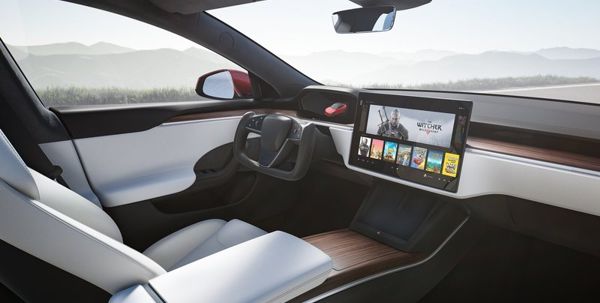
|
|
The
steering yoke is the silliest idea we have ever seen on a car's
interior...
|
|
The real problem is that steering yoke. It might look cool, but there
must be a good reason why a steering yoke has been using in aerospace
industry for decades but no one applies it to cars. In an aircraft,
the pilot never turns the steering yoke for more than half a turn. On
the Tesla, however, it takes 2.3 turns from lock to lock. This means,
in a tight corner or parking, you turn the yoke for more than a quarter
of turn and find no place to grip it. It is absolutely pointless, a
critical ergonomic shortfall. To make the issue worse, Tesla moves
the turn signal switches from column stalks to the touch-sensitive
buttons on the steering spokes, ditto the headlights, wipers and horn
buttons. Not only it is easy to touch and activate them accidentally,
it is also easy to forget where those buttons are when you are turning
the steering yoke. In particular, mislocating the hone button could
present serious hazards when you need to warn someone getting in the
way of your drive. The steering yoke is the silliest idea we have ever
seen on a car’s interior. And unbelievably, there is no way to opt for
a conventional steering wheel.
Nearly as annoying is the deletion of shifter. You don't change gears
in the Tesla, but still you need the shifter to engage reverse during
parking. Now you need to swipe a reverse slider on the touchscreen,
which appears automatically every time you touch the brake at low
speed. It is just not as intuitive as a conventional shifter. Tesla
doesn't care. It just wants to get rid of all hardware switchgears to
save costs.
The Plaid is shockingly quick, of course. At full-bore launches it
presses you so hard that breathing could become difficult. Although
1.99 seconds takes a drag race track and many attempts to achieve, Car
and Driver still managed an astonishing 2.1 seconds to 60 mph, 4.3
seconds to 100 mph and a quarter mile time of 9.4 seconds, tying with
Bugatti Chiron Sport, let alone any Ferraris or Lamborghinis currently
on sale. Fans of Tesla must say it is a giant killer. Moreover, unlike
any outgoing Performance models, the Plaid’s improved battery system –
now working at 460 instead of 400 Volt and has improved cooling, is
capable to repeat launch multiple times without falling into
overheating and self-restriction. Its performance is also noticeably
more sustainable to higher speeds. The motors now employ carbon-fiber
sleeves in rotors, reducing inertia thus allowing them to rev to 20,000
rpm, up from 16,000 rpm. Theoretically, this gives it a top speed of
200 mph, although the car is now restricted to 163 mph.
Unfortunately, testers also found the car unstable at high speeds,
something rarely heard these days. It becomes nervous to point you want
to back off well before reaching 163 mph. The steering doesn’t weigh up
enough, too. The brakes fade after a few high-speed stopping.
The Michelin Pilot Sport 4S tires with bespoke compounds offer
surprisingly a lot of grip, thanks in part to their extra widths:
compared with the outgoing Performance model, the front and rear are
widened by 20mm and 30mm respectively. Tesla claims a Nurburgring lap
time of 7:35, but like the 200mph claim, that might be achieved with a
prototype with different hardware. When being hustled in the twisty,
the Plaid’s torque vectoring rear axle fails to put down its power
effectively to the road. It could run into oversteer easily, then
trigger stability control to intervene abruptly. The steering offers
little feel in the process. Insanely quick it may be, Plaid is not a
true rival to BMW
M5 CS or AMG GT63 S 4-door.
So what is it? An American muscle car of the electric era? Damn close,
but the Tesla is more sophisticated than that. Starting at $130,000, it
is not cheap. Yes, to achieve the same straight line performance you
might need to buy a multi-million dollar hypercar, but the performance
of Tesla shines only on straight. As a driver’s car, it is far worse
than Porsche Taycan GTS which starts at the same price. Meanwhile,
conventional
performance sedans like M5 or E63 S still offer more fun and
refinement. I would rather see Tesla stops chasing
headline-grabbing numbers and gimmicks and starts concentrating on
making its cars better overall.
|
Verdict:    |
|